Solar Lights Elevate Your Garden Nighttime Charm
Solar lighting isn’t just for illuminating pathways or patios—it can transform your garden’s plants into nighttime showstoppers. By carefully selecting solar powered spot lighting, you can highlight the vibrant colors and textures of your flowers and foliage, making your yard a visual delight after dark. This article breaks the myth that “lights are only for people, not plants,” exploring how solar lamps enhance plant aesthetics, meet specific lighting needs for different species, and avoid common pitfalls. We’ll also clarify whether solar lights can double as grow lights and share practical “light + plant” pairing tips to elevate your garden’s charm.

Why Solar Lighting Enhances Your Garden’s Plants
Gardens come alive during the day, but at night, their beauty often fades into the shadows. Solar powered spot lighting changes that by accentuating the natural hues and shapes of your plants, creating a stunning nighttime display. Unlike traditional wired lights, solar lamps are eco-friendly, easy to install, and cost-effective, harnessing sunlight to power your garden’s glow. Whether it’s highlighting a blooming hydrangea or showcasing a lush fern, the right lighting can make your plants’ “colors pop” after sunset.
Beyond aesthetics, strategic lighting can subtly support plant health by providing gentle illumination without disrupting their natural cycles. However, misconceptions—like assuming all plants need bright, white light—can lead to lackluster results or even harm. Let’s explore how different plants benefit from tailored solar lighting and debunk common myths along the way.
Understanding Plant Lighting Needs
Not all plants respond to light the same way. From succulents to flowering shrubs, each type has unique needs that solar powered spot lighting can address when chosen thoughtfully. Here’s a breakdown of how to match lighting to popular garden plants:
Succulents and Foliage Plants: Low-Brightness Warm Light
Succulents, like echeveria or aloe, and foliage plants, such as ferns or hostas, thrive under low-brightness warm light (around 2700K-3000K). This soft, cozy glow highlights their textures—think the waxy sheen of a jade plant or the feathery fronds of a fern—without triggering leggy growth (etiolation). A solar spotlight with 10-20 lumens is ideal, casting a gentle glow that enhances their natural beauty while keeping growth patterns intact.
- Why it works: Warm light mimics evening sunlight, avoiding overstimulation.
- Tip: Place solar powered spot lighting 1-2 feet from succulents to create soft shadows that emphasize their shapes.
Flowering Plants: Neutral Light for Vibrant Colors
Flowering plants, like roses, hydrangeas, or lavender, shine under neutral light (3500K-4500K), which enhances color saturation without washing out delicate petals. For example, a neutral-toned solar spotlight can make a red rose appear richer or a purple salvia more vivid. Aim for 50-100 lumens to highlight blooms without overwhelming them.
- Why it works: Neutral light balances warmth and brightness, showcasing true flower colors.
- Tip: Angle spotlights upward to illuminate flower clusters, creating a focal point.
Avoiding Common Lighting Missteps
A frequent mistake is using overly bright or cool-toned lights (5000K+) for all plants, which can fade colors or disrupt growth cycles. For instance, cool white light may make green foliage look washed out and can stress light-sensitive plants like calatheas. Another pitfall is assuming all solar lights are equal—low-quality models may flicker or fade, diminishing the effect. Always choose high-quality solar powered spot lighting with adjustable settings for the best results.
Can Solar Lights Replace Grow Lights?
A common question is whether solar powered spot lighting can double as grow lights for plants. The answer depends on the goal:
- Short-term decorative lighting: Solar spotlights are excellent for enhancing a garden’s nighttime appeal. They can provide supplemental light for a few hours, accentuating plants without disrupting their natural cycles. For example, a solar spotlight on a flowering shrub can highlight its blooms during an evening gathering.
- Long-term plant growth: Solar lights aren’t a substitute for professional grow lights. Grow lights deliver specific wavelengths (red and blue spectra) at consistent intensities to support photosynthesis and growth. Solar lights, while versatile, lack the precision and power for sustained plant development, especially for indoor or high-demand species like tomatoes or orchids.
For decorative purposes, solar lights are a fantastic choice, but for serious plant growth, invest in dedicated grow lights. To bridge the gap, you can use solar lights for evening aesthetics and grow lights during the day for plants needing extra support.
Top “Light + Plant” Pairing Formulas
Pairing the right solar light with the right plant can transform your garden into a nighttime masterpiece. Here are some proven combinations to inspire you:
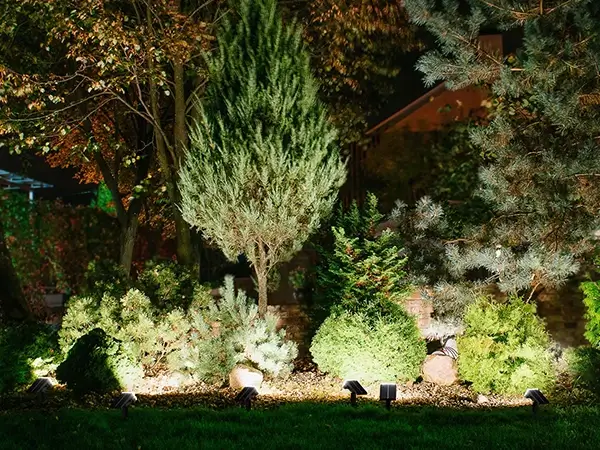
Hydrangea Clusters with Spherical Solar Spotlights
Hydrangeas, with their lush, rounded blooms, pair beautifully with spherical solar powered spot lighting. These lights, often designed as glowing orbs, mimic the shape of hydrangea flowerheads, creating a cohesive look. Place 50-lumen neutral-toned spotlights at the base of hydrangea bushes, angled upward, to highlight their vibrant pinks, blues, or whites. The soft glow enhances petal saturation while casting gentle shadows for depth.
- Setup tip: Space lights 2-3 feet apart for even coverage.
- Why it works: The spherical design complements hydrangea’s natural form, creating a harmonious display.
Climbing Roses with Solar String Lights
Climbing roses or clematis on trellises or pergolas come alive when wrapped with solar-powered string lights. These delicate, warm-toned lights (2700K) weave through the vines, highlighting blooms and creating a romantic, fairy-tale effect. Use weatherproof string lights with small, evenly spaced bulbs to avoid overpowering the delicate flowers.
- Setup tip: Drape lights loosely to follow the vine’s natural growth pattern.
- Why it works: Warm light enhances the rich reds and pinks of roses, adding warmth to the scene.
Fern Beds with Low-Profile Path Lights
Ferns or other low-growing foliage plants pair well with low-profile solar path lights. These lights, often stake-mounted, sit close to the ground (1-1.5 feet high) and emit a soft, warm glow (10-20 lumens) that highlights the intricate textures of fern fronds. The subtle illumination creates a serene, woodland-like atmosphere.
- Setup tip: Place lights along the edge of fern beds, spaced 3-4 feet apart.
- Why it works: Low brightness preserves the delicate, natural look of foliage.
Avoiding Plant Lighting Pitfalls
To ensure your solar lighting enhances your garden without harming plants, steer clear of these common mistakes:
- Overlighting: Too much light, especially cool-toned, can stress plants or fade colors. Stick to 10-100 lumens depending on the plant type.
- Poor placement: Lights too close to plants can cause heat stress, while those too far away may not highlight details. Aim for 1-3 feet of distance.
- Inconsistent charging: Ensure solar panels get 6-8 hours of direct sunlight daily to maintain reliable performance.
- Ignoring plant sensitivity: Light-sensitive plants like peace lilies or calatheas need softer, indirect lighting to avoid leaf burn or stress.
By choosing high-quality solar lights and tailoring their placement to your plants’ needs, you’ll create a vibrant, healthy garden that shines at night.
Real-Life Garden Transformation: The Carter’s Story
To see solar powered spot lighting in action, consider the Carter family, who revamped their backyard to highlight their prized plant collection. Their garden featured succulents, roses, and a hydrangea border, but at night, it faded into darkness, losing its charm.
The Challenge
The Carters wanted their garden to impress guests during evening barbecues but struggled with dim, unreliable lighting. Their succulents looked dull, and their roses were barely visible after sunset. They also worried about overlighting, which had previously caused their ferns to droop.
The Solution
The Carters installed a mix of solar lights tailored to their plants. For their succulent bed, they used 15-lumen warm white spotlights (3000K), placed 2 feet away to highlight textures without overstimulation. Their climbing roses on a trellis were adorned with solar string lights (2700K), creating a glowing canopy. For the hydrangea border, they chose 50-lumen neutral-toned spherical spotlights, angled to showcase vibrant blooms.
The Results
The garden became a nighttime focal point. Guests raved about the vivid colors of the roses and the soft glow on the succulents. The hydrangeas, illuminated by spherical lights, looked fuller and more vibrant. The Carters also appreciated the easy installation—no wiring or electrician needed—and the eco-friendly solar power. Their garden now shines as a welcoming, beautiful space day and night.
Key Takeaways
- Tailored lighting: Matching light type to plant needs enhanced aesthetics.
- Eco-friendly choice: Solar lights reduced energy costs and maintenance.
- Strategic placement: Proper angles and distances maximized visual impact.
- Nighttime appeal: The garden became a year-round showpiece.
Why Choose Solar Lighting for Your Garden?
Solar powered spot lighting offers a versatile, sustainable way to elevate your garden’s beauty. By understanding your plants’ lighting needs—warm light for succulents, neutral light for flowers—you can create a stunning nighttime display that highlights colors and textures. Avoiding common pitfalls, like overlighting or poor placement, ensures your plants stay healthy while looking their best.
Solar lights are also a practical choice: they’re easy to install, require no wiring, and run on free solar energy. Whether you’re highlighting a single rose bush or an entire garden bed, the right solar lighting can make your plants “pop” after dark, turning your yard into a visual masterpiece.
Getting Started with Solar Garden Lighting
Ready to transform your garden? Start by assessing your plants’ needs—succulents, foliage, or flowering—and choose solar lights with appropriate brightness and color temperatures. Experiment with pairings like spherical spotlights for hydrangeas or string lights for climbing vines. Ensure solar panels get ample sunlight, and position lights to highlight your plants’ best features. For inspiration, revisit the Carter family’s story to see how thoughtful lighting can elevate any garden.
With solar powered spot lighting, your plants can shine as brightly at night as they do during the day, creating a vibrant, inviting garden for all to enjoy.

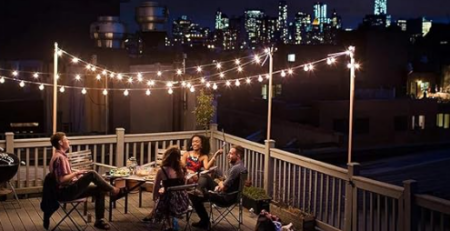
-4-2-450x231.webp)
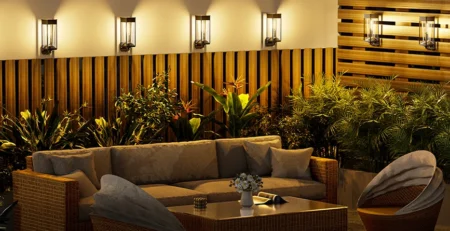
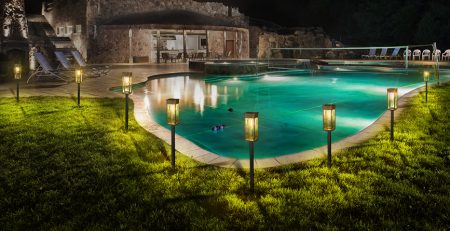
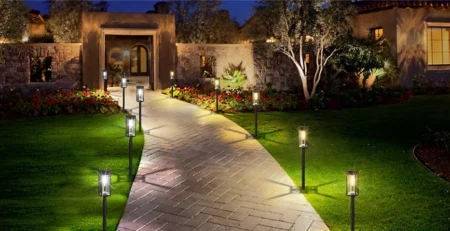
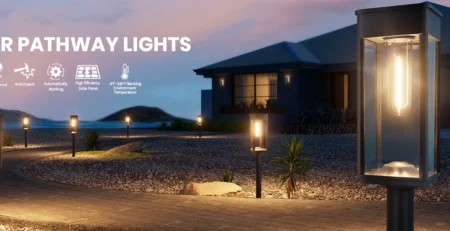
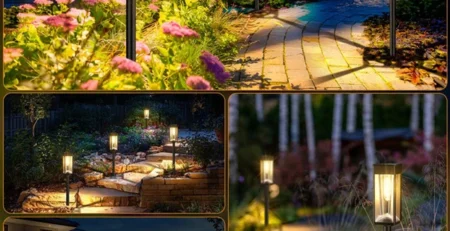
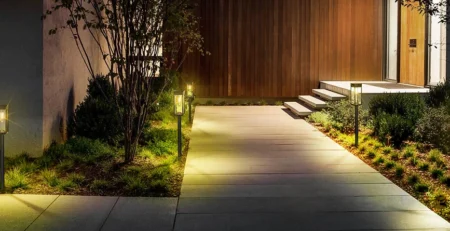
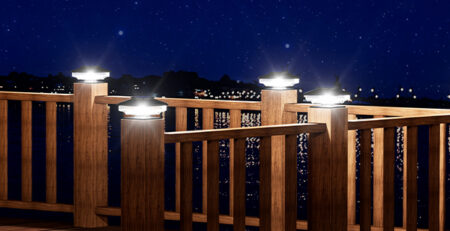

Leave a Reply